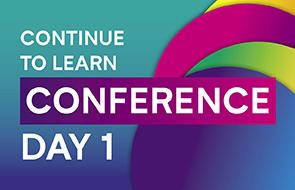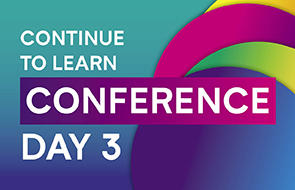- Homepage
- Event listing
- Continue to Learn Conference - Day 2
Continue to Learn Conference - Day 2
Conference - Wednesday 20 January (Day 2)
Information for delegates
Ticket holders will be able to access the Conference platform from 9am - 3pm for networking. The sessions will commence at 10am and will end between 2-2.15pm.
Additional content will be added as it is confirmed. Content is subject to change.
Full Access includes both Standard and Full Access sessions
Day 2 Standard Access
Day Two General session - Greenkeeping through and beyond the Pandemic
The Covid pandemic has shone a spotlight on to golf courses and greenkeepers like never before. It has also provided unprecedented challenges in terms of reduced maintenance, incredible surges of play and yet another set of climatic challenges. In this session we will look at quantifying some of those challenges and identifying opportunities to improve the appreciation and respect for greenkeepers at the end of the crisis.
Presented by BIGGA CEO, Jim Croxton and guests.
Golf Course 2030: Standards for the golf course
R&A Golf Course 2030 project
Golf green quality has been a discussion point since the first golf green was built. Over the years, various efforts have been made, with varying success, to produce golf green quality standards. However, what is meant by the term quality? This could purely focus on the quality and nature of ball surface interaction or it could also focus on the visual aesthetic and “playability” of the green and its architecture. The objectives of this STRI managed project have always been to understand and set out what is meant by golf green quality, understand the relationships among the key factors, review how golf green quality can be
assessed and the methods available for doing this.
Beyond the greens, golf course standards should be an important element of effective performance-based management, resource efficiency, and player satisfaction. The University Centre Myerscough managed project aims to provide a coherent and consistent set of real-world standards for various areas of the golf course environment, including tees, fairways, green approaches, bunkers and mown rough.
This session aims to:
• Provide an overview of the rationale of the projects and their key aims
• Present the work completed to date, defining the concept of quality in both broad and narrow contexts
• Reflect on the opinions of stakeholder groups in relation to quality standards
• Outline findings to date, possible criteria and “standards” to be adopted for golf course areas
• Identify the work still in progress and timescale for completion
Presented by:
- Dr Stewart Brown, Senior Lecturer – Sportsturf Agronomy, University Centre Myerscough
- Dr Christian Spring, Research Operations Manager, STRI Group
- Dr John Fry, Research Lead for Sport, University Centre Myerscough
Develop your personal brand
Building a strong personal brand is centred around your reputation built by more than agronomics and conditioning. Becoming a person of character is a decision that you make every single day and impacts your personal brand.
Presented by Tyler Bloom, Tyler Bloom Consulting
Golf Course 2030: Perspectives on the future of greenkeeper education
R&A Golf Course 2030 project
Bringing together two projects carried out as part of the R&A's Golf Course 2030 initiative, this session will provide an overview of the combination of impacts from climate change, resource constraints and regulation and why it will require an agile, adaptable and resilient greenkeeping workforce. The ability to adapt to change will be critical and the education provided to greenkeepers throughout their careers must reflect this. The skills to meet these challenges demands respect and the profile of the course manager must be raised to recognise their talents and professionalism.
Learning outcomes:
The knowledge, skills and management competences that will be required by the golf course manager and greenkeeper of the future.
Does the existing curriculum for greenkeeper/course manager education meet the competence needs of the future?
What the barriers to entry into a career in greenkeeping and golf course management are
What the current perceptions within the golf community (professionals, club managers and administrators, golfers) of the role and value of the golf course maintenance workforce
Presented by Dr Paul Miller, Senior Lecturer in Golf Course Management, SRUC
Large scale organic matter management in preparation for major tournaments
In this session Steve will cover both the biological and cultural programs he used to overcome a significant organic matter issue on the fairways of the PGA Centenary Course in preparation for the hosting of the 2014 Ryder Cup.
Presented by Steve Chappell, Golf Course Superintendent, Royal Bled Golf Club
Introducing Soil Scout - Below ground, wireless moisture management
An automatic soil moisture sensing system that is buried in the root zone of your turf. Each sensor is wireless with a battery that can last up to 20 years and relays information back to a base station every 20 minutes, every hour, every day. Informs on moisture content, temperature and salinity of your soil in an easily readable graphic display.
Presented by Peter Corbett, Chemicals Product Manager - Rigby Taylor Ltd
Practice makes perfect…How to create successful habits
This session will help you understand how to create successful habits.
Learning outcomes:
The difference between behaviour and habit and how to achieve the transition
How to build a successful and resilient team foundation and make it stick
How to deliver a team vision with clearly defined and measurable goals
The importance of communication and how to formalise learning
Presented by Phil Helmn MG
Bio-Nutrition: Unlocking the True Potential of Your Turf
Bio-nutrition does not solely rely on the use of certain agricultural products, but involves the implementation of a set of specific management techniques aimed at creating a sustainable turfgrass system. This presentation will discuss the impact of cultural and chemical practices on turfgrass growth and how those practices ultimately pose certain challenges to turfgrass managers. Focus must be placed on revitalizing the soil, repopulating rootzone microorganisms, applying appropriate nutrients, and connecting turfgrass with the soil for the system to function at optimal potential. Specific attention will be placed on use of biostimulants and biofertilizers and where they fit into the overall management scheme.
Presented by Dr. Gerald Henry, Athletic Association Endowed Professor, University of Georgia
Golf Course 2030: The decision-making process for grass selection
R&A Golf Course 2030 project
Adjusting sward species composition to one which results in both better playing qualities and greater sustainability takes significant time to accomplish and requires the growing environment to be right to allow change to occur. On top of this, the challenges likely to occur on golf courses over the next 10 years, in terms of resource availability, climate change impacts and regulatory pressures, there is a vital need to develop guidance to help with the decision-making process about grass selection, be that for cool season, warm season or transition zone areas.
Learning outcomes:
Creating a decision-making process for grass selection for golf courses
Highlighting the relevant factors that influence grass selection
Assessing the key characteristics of grass that relate to grass selection
Identifying key strategic objectives behind grass selection and rationale for change
Discussing of the main drivers behind grass selection
Outlining the decision-making process for choosing the right grasses for the right situation
Helping greenkeepers and course managers understand what would be appropriate grasses for their course and help them think critically about what grasses they currently have and are they “future proofed”.
Presented by:
- Hui 'Eric' Chen, Research Manager, STRI Group
- Dr Christian Spring, Research Operations Manager, STRI Group
The future of integrated turf management
Dan and Glenn take a look at the future of Turf Management and how greenkeeping practices and the products we use may develop in the next 20 years.
Presented by Daniel Lightfoot MG and Glenn Kirby, Syngenta
Maximising turf pest control with nematodes
Entomopathogenic nematodes are natural predators of turf pests. Lots of folklore, myths, and fake news surrounds their use and acceptance as part of a serious pest control programme. This talk will explain what they are, how they work, and how incorporating them into your management practices will enable you to achieve effective control of turf pests.
Presented by Colin Mumford, Technical Support Manager, Bayer Crop Science
Trees and Golf Courses – can they live together?
BIGGA's James Hutchinson introduces us to trees on golf courses and why they should be managed for the benefit of all involved.
Presented by James Hutchinson, Membership Services Manager - sustainability and ecology, BIGGA
A selection of 12 On Demand videos from the Continue to Learn archives
Watch a selection of On Demand videos from the Continue to Learn archives:
- Seven things I've learned about turf around the world (NRC 2020) – Micah Woods, Chief Scientist, Asian Turfgrass Center
- The renovation of Loch Lomond - Part 1 (NRC 2020) – David Cole MG, Director of Golf Course and Estates, Loch Lomond Golf Club
- The new 7th hole at Royal Dornoch (C2L 2020) – Tom Mackenzie, Golf Course Architect, Mackenzie & Ebert and Eoin Riddell, Course Manager, Royal Dornoch Golf Club
- The Ryder Cup - past, present and future (C2L 2017) - Jim McKenzie MBE, Director of Golf Courses & Estates Management, The Celtic Manor Collection; Curtis Tyrrell MG CGCS, Director of Golf Course Operations, Medinah Country Club; Steve Chappell, Head Greenkeeper - PGA Centenary Course, Gleneagles; Chris Tritabaugh, Golf Course Superintendent, Hazeltine National Golf Club; Alejandro Reyes, Course Manager, Le Golf National
- Green speed is more than a number (C2L 2019) – Micah Woods, Chief Scientist, Asian Turfgrass Center
- Maximise your personal impact (C2L 2019) - Mark Doyle, Managing Director, The Method
- Getting Royal Portrush ready for the Open (C2L 2020) - Martin Ebert, Golf Course Architect, Mackenzie & Ebert and Graeme Beatt, Course Manager, Royal Portrush Golf Club
- Non-Chemical Management Strategies for Turf Insects - Leatherjackets and Chafer Grubs (C2L 2019) - Dr Pat Vittum, Professor to Turf Entomology, University of Massachusetts
- 80% People / 20% Turf ‑ The Importance of Creating the Right Culture in the Workplace (C2L 2020) - Craig Haldane, Golf Course Manager, The Gleneagles Hotel
- Turning the turf management dials (C2L 2015) – Chris Tritabaugh, Golf Course Superintendent, Hazeltine National Golf Club
- More than miracles (C2L 2017) – Curtis Tyrrell CGCS MG, former Director of Golf Course Operations, Medinah Country Club
- Flying Blind – Micah Woods latest video release - Micah Woods, Chief Scientist, Asian Turfgrass Center
Day 2 Full Access
How to best utilise plant growth regulators to optimise turf health and performance
Plant growth regulators (PGRs) are one of the most common products used on fine turf areas. They are used for a variety of reasons, including improving turf health, discouraging Poa annua and providing faster and more consistent green speeds. This presentation will explain how to best utilise different products to achieve your specific goals.
Presented by Zach Nicoludis, Central Region Agronomist, USGA Green Section
The renovation of Loch Lomond – Part two
Since winter 2017/18 the team at Loch Lomond and golf construction contractors Golflink have almost completed what’s considered to be one of the biggest renovations in British golfing history. Taking place over three consecutive winters, in one of the wettest locations in the UK, 16 holes have been rebuilt, a new irrigation system installed, a full rebuild, extension and new forwards tees added, bunkers rebuilt as well as the renewal of the all-important drainage infrastructure, sand cap and re-grassing plan across the golf course. The last 2 holes are planned to be completed this winter (if no covid lockdowns restrictions)
Following up on the part 1, David Cole MG will continue with how he and his team undertook the massive renovation works.
Part 1 will be available to watch again on the conference platform.
Presented by David Cole MG, Director of Golf Course and Estates, Loch Lomond Golf Club
Fraise mowing applications for playability and weed control on the golf course
Practices that remove turfgrass verdure and surface organic matter offer significant benefits for improving surface firmness, introducing new turfgrass species and varieties, and reducing weed infestation. Exploratory research has begun to identify strategies that integrate fraise mowing into routine golf turf management programs.
Presented by Dr Frank Rossi, Associate Professor of Horticulture "Grass Guy", Cornell University
How to develop and create great teams
This session will help you to develop and create great teams.
Learning outcomes:
Effective models for developing, managing and leading successful teams
How to assess current and future team capabilities and requirements
Methods to monitor and manage development
How to create and support high performing teams
Presented by Phil Helmn MG
Golf course architecture - Doing outside of the box!
Agustin (Augie) Pizá will present his processes and techniques which help him maximize his creativity and vision for his award winning projects. His “Doing-Outside-of-the-Box” approach will hopefully encourage attendees to unlearn and create a critical thinking approach to their professional life. Take risks and produce “Out-of-the-Box” options and solutions for new golf course designs or renovation challenges.
He will share how he has taken a standard renovation and elevated an entire project by implementing his "Reassessment Techniques.” Some examples and case studies which will be shown include the openness of “What if?” Design for the Inclusion of new and non-golfers (Real important to create other avenues for better or different ROI). These and other approach techniques will be shared.
Presented by Agustin Piza, Founder, Piza Golf,
From Grasscutter to Scientist….the fairway to education
This session examines the changes in the management of turfgrass over the past years and gives insight into how we can best utilise these advances via best management practices and education.
With a look back on 40 years of greenkeeping experience; turfgrass management in the 1980’s, and how conditions, equipment, products, and techniques have developed over the years. What has had the greatest impact on turfgrass management during this time, enhanced equipment and products and also the increased challenges – chemical restrictions, environment issues, climate change and the personal pressure greenkeepers must deal with.
The key to developing and utilising all these changes and challenges is Education! Today's turf managers are responsible for the maintenance and presentation of a multi-million pound asset. Science is required to produce quality sports surfaces used by many millions of people either as participants or spectators, Plant biology and physiology, Soil science, Turfgrass species, Cultivation and construction practices, Drainage, Irrigation, Machinery management, Personal management and Pests and diseases!
This session will include a guide to the educational pathways available today and a look at the trials and tribulations of higher education while working full time, but also the rewards of following this educational pathway.
Learning outcomes
An insight into golf course management techniques and conditions that were prevalent in the 1980's and 90's and how these changes and developed
How the introduction of new equipment, products and techniques impacted golf course maintenance
An understanding of the challenges greenkeepers face today, chemical restrictions, environmental concerns, climate change, and personal well being
Education for greenkeepers, how this is vital for career development, an understanding of the scientific requirements for today's professional
The educational pathways available in the UK and Ireland, from basic greenkeeping courses, through Foundation Degrees and all the way to a Doctorate
Be able to evaluate the level of education suited to your own situation and understand the challenges of pursuing these pathways while also working full time.








